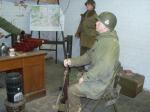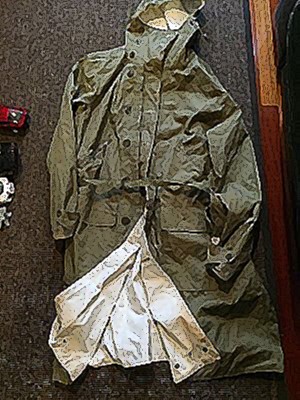
|
|||||||||||||||||||||||||||||||||||||||||||||||||||||||||||||||||||||||||||||||||||||||||||||||||||||||
Prior to World War II the U.S. military used fur or sheepskin linings and fur trim on cold weather garments, as was the practice in general civilian use. However, the mass production requirements of the War along with new technology changed that forever. Wool, in the form of underwear, sweaters, shirts and trousers, mufflers and mittens continued to be used but there was a steady trend away from natural furs. Pile, a plush type material, became the choice for inner linings in particular. The Army began looking at pile linings for several reasons, as part of the general move toward layered clothing. The Canadian military had already made this decision by 1941. There was idle textile production capacity in U.S. industry since civilian automobile production had stopped. Quartermaster cold chamber tests in March 1942 proved that pile was as satisfactory as fur, there was no loss of performance. Compared to shearling, good quality pile was lighter and equally warm in still air. Pile did less well in wind, so windproof shells were used as an outer layer. The combination of shell and liner was still lighter than fur coats. Sources of alpaca and mohair, the chief materials used for pile, were relatively plentiful. Finally, the Army would rather rely on the plush looms of U.S. industry for its mass production requirements than the fragmented and far flung fur trapping industry which served a limited luxury market. By 1943 pile was the basic material for Arctic and cold weather procurements. {Photo, left: U.S. Army in Iceland, Christmas 1942) The Arctic Parka Program
The reversible, fur trimmed cloth parka was put in production for Arctic use at the same time a similar parka was adopted for use by the then new mountain troops. The 1941 version of that coat was khaki and not reversible. It had a wide belt and a zipper on the hood allowing it to be opened up. The lining was alpaca or sheepskin (photo, above, left). In 1942 a new reversible parka was designed for general use in cold climates, replacing both former items as a warm but lightweight outer garment. The fur parka was eventually dropped from the list of Arctic clothing while "overcoat parka" garments continued to develop with pile linings. {Photo, right: Army engineer surveying for the Alcan Highway, 1942) The first pile garment was a parka coat with the pile attached to a windproof outer shell. This made it suitable for severe conditions only and was not an improvement over the shearling coats. A number of experimental pile parkas were made up in the winter of 1941 and were tried out, along with shearling coats, in tests during March of 1942. The result of the tests and further design was a new pile parka overcoat with pile lining and reversible outer poplin shell. Overcoat, Parka Type, ReversibleThe 1943 pattern of the "Overcoat, Parka Type, Reversible" was a full length parka with a hood, offering full body protection from the head to below the knees. It was reversible with an olive drab side and a white snow camouflage side. A long zipper closed the front with a button flap over it, plus three buttons at the neck to close the hood. There were two hand-warmer slash pockets above the web-belted waist and two large cargo pockets below (on the OD side). The bottom hem and the hood both had snaps that could be used to adjust the size. The sleeve cuff could be drawn tight with a two position strap and buttons. The button-in pile liner had knitted cuffs at the wrist to help seal out the cold. This garment was intended to replace the shearling and the earlier pile parka coats, having advantages over both of them in that it was adaptable to a wide range of temperature conditions and its two piece design made drying and cleaning much easier. This garment went into immediate production, but experimentation continued. A few other designs went into limited production and special models of parkas were developed for mountain ski troops or Arctic conditions. Summary of World War II Parkas
The Parka, Air Force models D-1 and D-2 were developed for mechanics and service personnel who had to work outdoors on the flight line for long period of time in cold weather. Other parkas or arctic-wear overgarments were designed and issued for women and specialized military occupations (nurses, freezer workers, et al.) as well as by the U.S. Navy. |
|
Droit d’auteur La plupart des photographies publiées sur ce site sont la propriété exclusive de © Claude Balmefrezol Elles peuvent être reproduites pour une utilisation personnelle, mais l’autorisation préalable de leur auteur est nécessaire pour être exploitées dans un autre cadre (site web publications etc) Les sources des autres documents et illustrations sont mentionnées quand elles sont connues. Si une de ces pièces est protégée et que sa présence dans ces pages pose problème, elle sera retirée sur simple demande. Principaux Collaborateurs:
Nb
de visiteurs:7074764 Nb
de visiteurs aujourd'hui:1199 Nb
de connectés:73 | |||||||||||||||||||||||||||||||||||||||||||||||||||||||||||||||||||||||||||||||||||||||||||||||||||||





.JPG)
.JPG)
.JPG)
.JPG)
.JPG)
.JPG)
.JPG)


